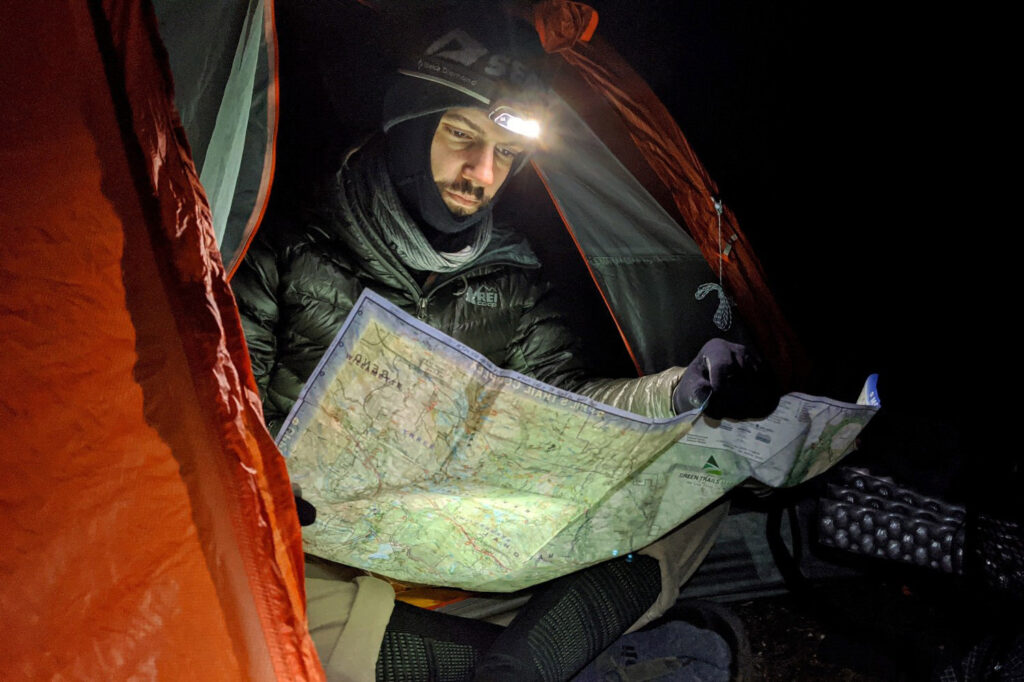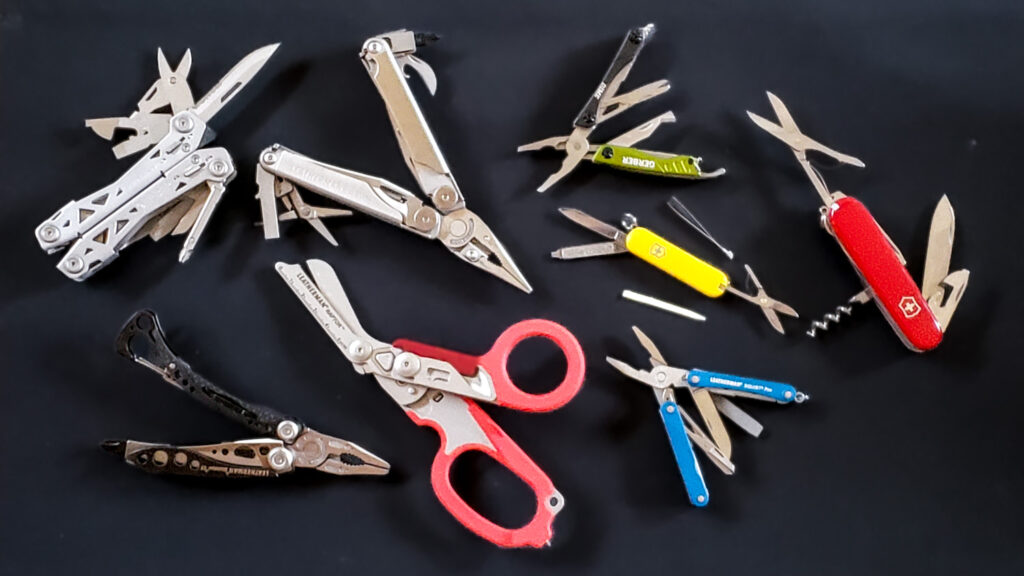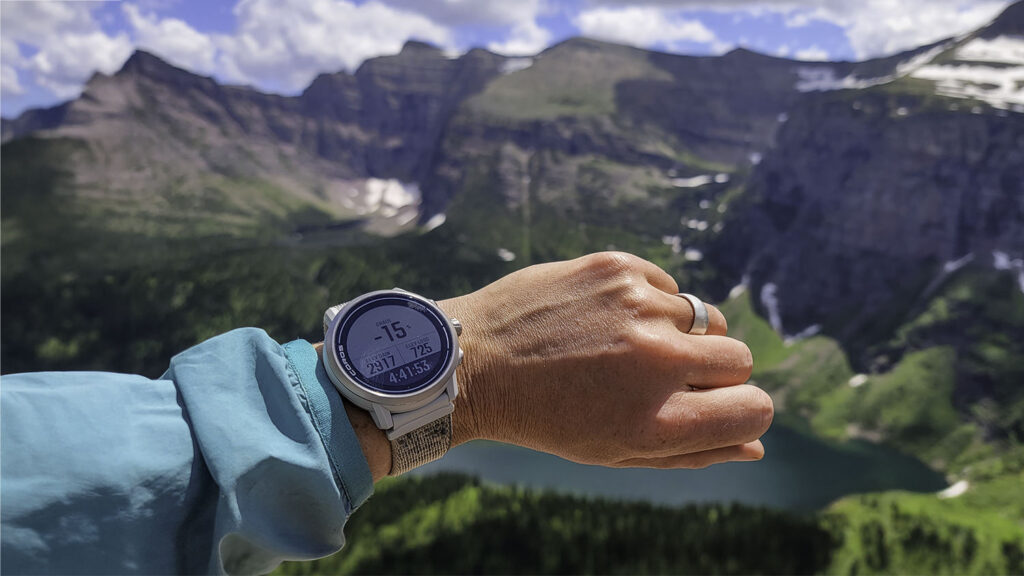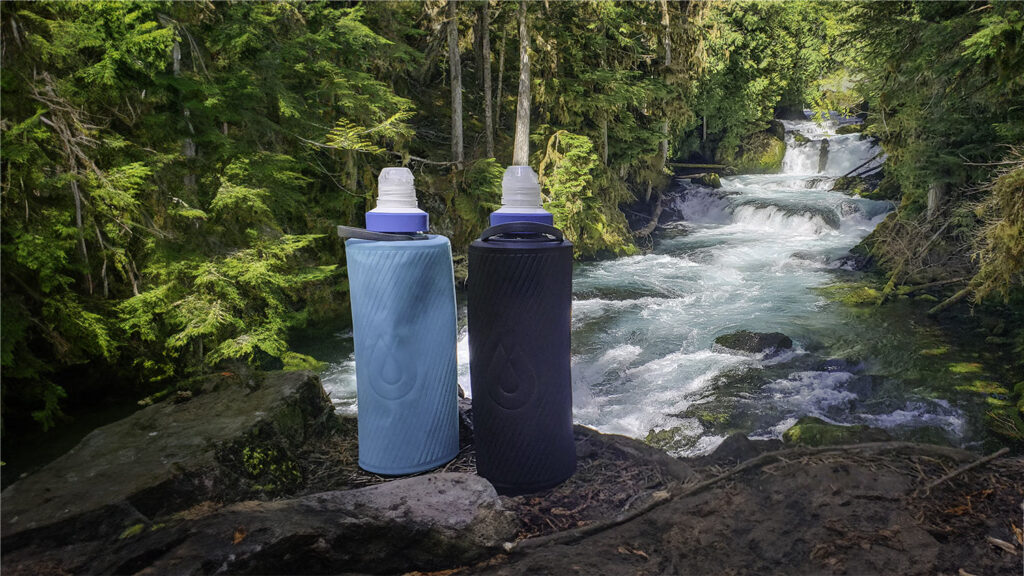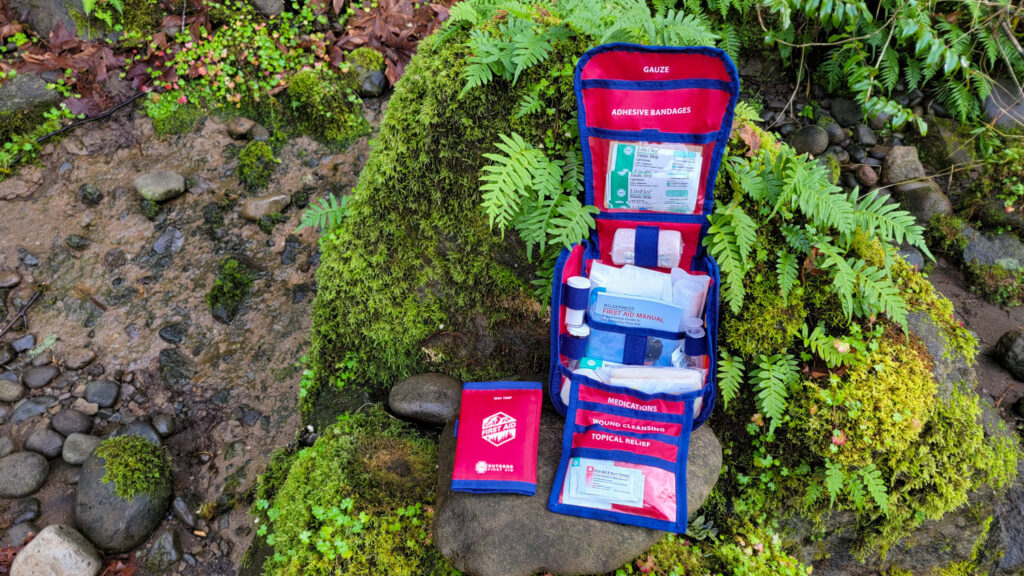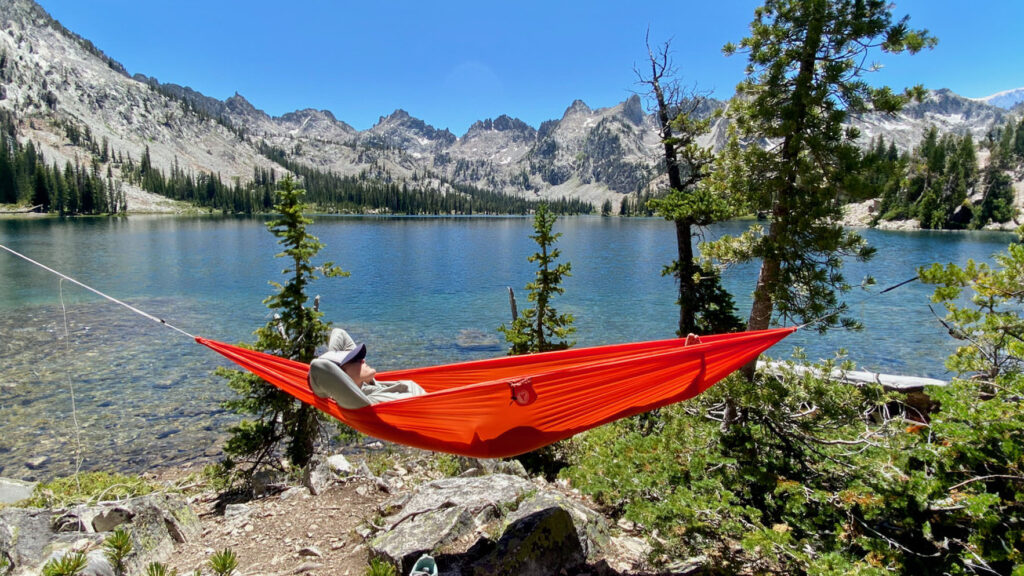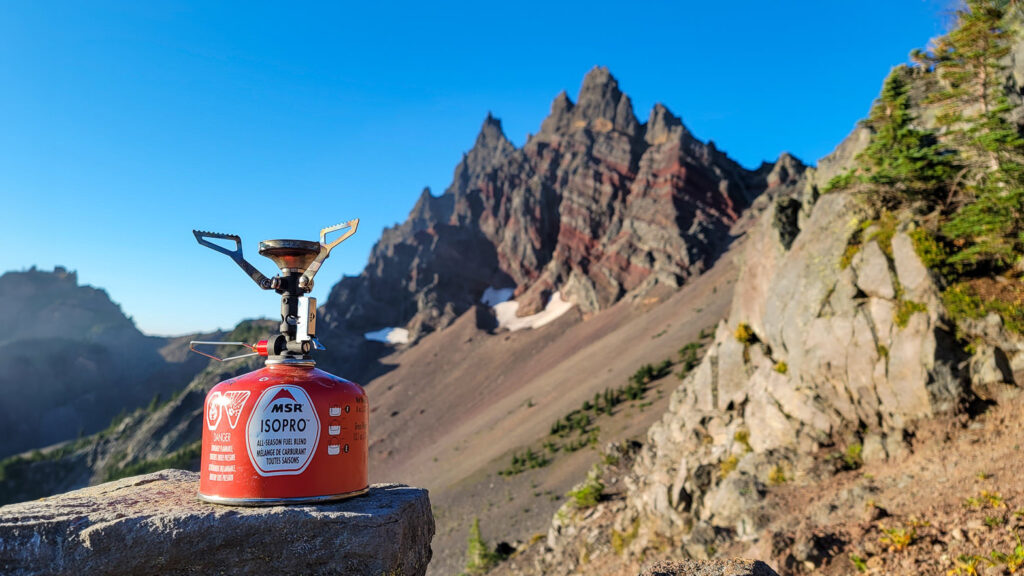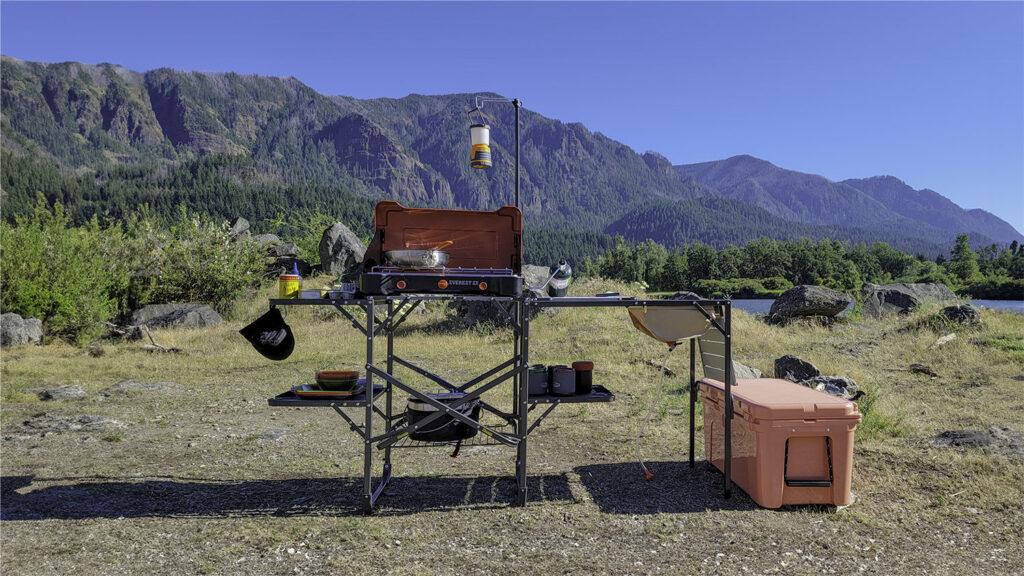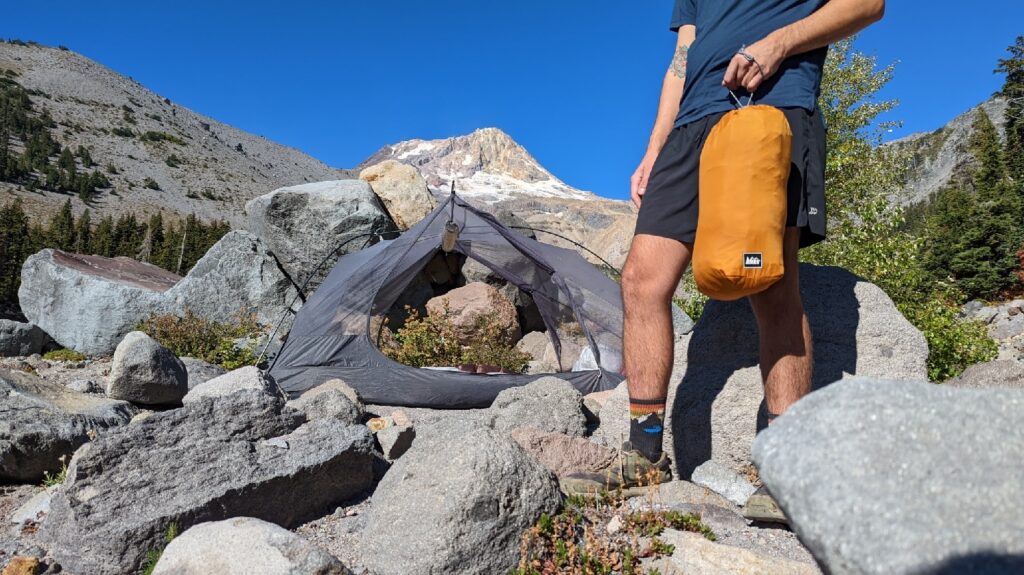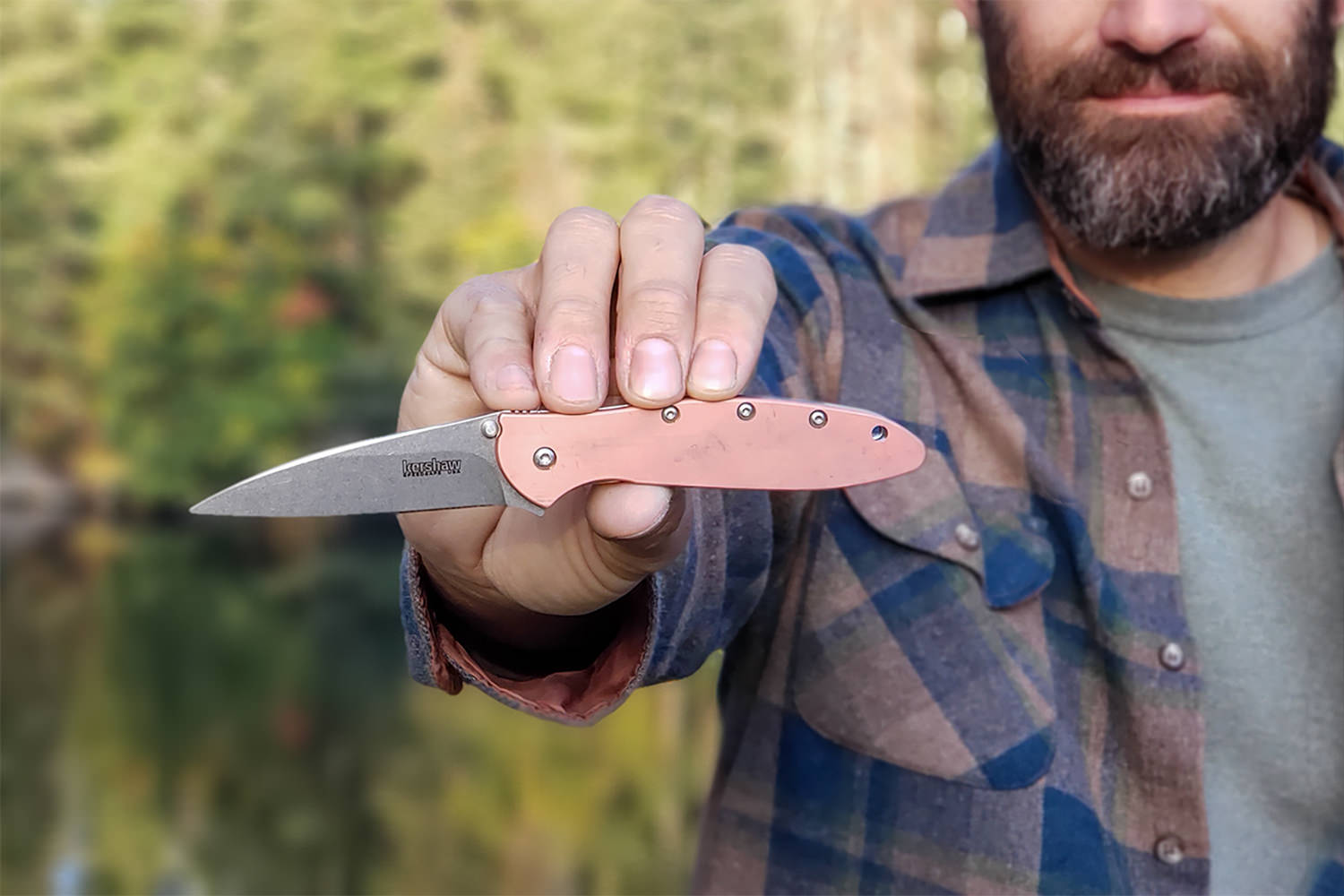
A reliable pocket knife is indispensable for handling daily tasks and a must-have tool on the trail. Whether on a trail needing a dependable blade, opening packages, or facing an emergency, having a trustworthy blade can make all the difference.
Our team tested over 30 pocket knives from brands like Kershaw, Benchmade, Opinel, Gerber, and more, assessing key factors like blade material, build quality, blade retention, ergonomics, locking mechanisms, corrosion resistance, and weight. We evaluated these knives in diverse real-world conditions, from backyard use to applications on lakeshores in MN and backpacking trails in WA, to ensure our recommendations are grounded in thorough, practical experience.
And for more info, check out some of our other popular gear guides:
Quick Picks for Pocket Knives
Check out this quick list of our favorites if you’re in a hurry, or continue scrolling to see our full list with in-depth reviews.
Best Pocket Knife Overall: Kershaw Leek ($61)
Best Ultralight Pocket Knife: Benchmade Bugout 535 ($171)
Best Budget Pocket Knife: Opinel No. 8 ($19)
Best Premium Pocket Knife: Spyderco Para Military 2 ($282)
Best EDC (Everyday Carry) Pocket Knife: CRKT Squid ($40)
Durable & Affordable Pocket Knife: Gerber Paralite ($31)
Workhorse Pocket Knife with an Ergonomic Handle: Kershaw Blur ($115)
Small & Quick-Opening Pocket Knife: Sog Twitch ($45)
What’s new
The Clever Hiker team has been carving, chopping, and splicing with some of the sharpest new pocket knives to hit the market and comparing them against our long-time favorites. As a result, this list has seen some changes:
- The Kershaw Leek leads the pack as a sharp, easy-to-use blade with a durable and sleek profile that can open with one hand.
- We’ve added the Gerber Paralite as an easier-to-use, durable option suitable for everyday situations.
OVerall Testing Scores for Pocket Knives
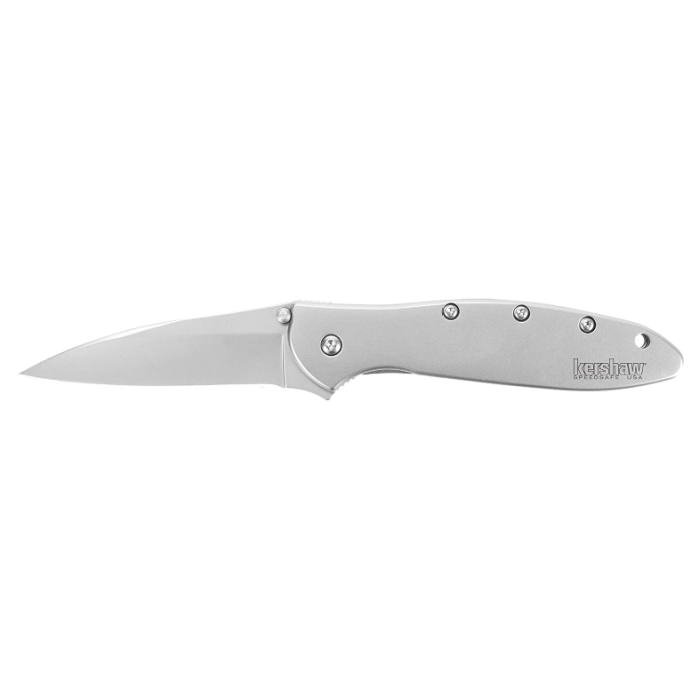
Kershaw Leek
Best Pocket Knife Overall
CleverHiker Rating: 87
Price: $61
Measured Weight: 3 oz.
Blade Length: 3 in.
Overall Length: 7 in.
Blade Material: 14C28N stainless steel
Pros
- Very sharp
- Slim and compact
- Easy to open with one hand
- Enhanced safety features
- Secure hand feel
Cons
- Blade tip is a bit thin for rugged jobs
- Can develop rust if not well-maintained
Whether you’re a knife enthusiast or a novice, the Kershaw Leek will quickly become your favorite pocket knife. It is highly portable, performs well, and is a reasonable price for the quality. With its 3-inch blade crafted from high-performance steel, the Leek is well-suited for general use and specialized applications. Its slim, stainless steel handle contours for a comfortable grip and the assisted opening mechanism ensures that the blade springs into action with a smooth, single-finger flick.
The Tip-Lock system provides added security by keeping the blade safely closed when not in use. The knife’s sleek design makes it exceptionally easy to carry, and its razor-sharp blade maintains a durable and easy-to-resharpen edge.
While the Leek is a top performer, minor issues are always possible. For instance, occasional surface rust may develop due to the nature of stainless steel, though it usually cleans off with appropriate maintenance. Additionally, some may experience slight difficulties with the blade lock not fully engaging. However, these minor concerns can be fixed with a few adjustments or maintenance.
If you’re seeking a stylish and functional knife that you’ll be eager to use daily, the Kershaw Leek is an excellent choice. It is best suited for those who need a reliable, compact knife for everyday tasks like precise cutting and detailed work. It is ideal for both general use and more specialized cutting chores.

Benchmade Bugout 535
Best Ultralight Pocket Knife
CleverHiker Rating: 81.5
Price: $180
Measured Weight: 1.9 oz.
Blade Length: 3.24 in.
Overall Length: 7.46 in.
Blade Material: CPM-S30V stainless steel
Pros
- Very lightweight
- Compact design
- Lock keeps fingers clear while closing
- Inconspicuous carrying
- Excellent edge retention
Cons
- Expensive
- Handle is long
The Benchmade Bugout 535 is a high-quality, ultralight pocket knife that excels in functionality and ease of carry. Designed with a drop-point blade, it offers exceptional edge retention and versatility. The blade finish provides a sleek look and adds a layer of durability and corrosion resistance.
One of the Bugout’s most notable features is its lightweight construction. The textured handle provides a more comfortable grip and is easy to manage. The manual lock mechanism is secure and ambidextrous, making it user-friendly for left- and right-handed users.
There is a lot to love about this knife, but while testing, we noticed that the pivot was too tight. This can be adjusted for smoother action fairly quickly. The lightweight nature of the knife is a pro for many but makes it less suited for heavy-duty tasks. The pocket clip, while functional, is short and isn’t quite as secure as the longer pocket clips tested. However, the oversized lanyard hole and the reversible, deep-carry pocket clip provide versatile carrying options and the potential for a more inconspicuous carry.
The Benchmade Bugout 535 is great for individuals seeking an ultralight, high-performance knife for everyday carry and light-duty tasks.

Opinel No. 8
Best Budget Pocket Knife
CleverHiker Rating: 66.5
Price: $19
Measured Weight: 1.5 oz.
Blade Length: 3.25 in.
Overall Length: 7.59 in.
Blade Material: 12C27 Sandvik stainless steel
Pros
- Affordable price
- Very lightweight
- Secure collar lock
- Comfortable handle
- Inconspicuous
- Customizable engraving available
Cons
- Not as sharp as some
- Slower two-handed open (nail nick and collar lock)
- No pocket clip
The Opinel No. 8 is a budget-friendly, reliable knife with a simple design. Weighing just 1.5 ounces, it is exceptionally lightweight and portable, making it an excellent choice for hiking, foraging, picnicking, and gardening. Its Sandvik 12C27 stainless steel blade is effective for slicing foods like meats, cheeses, and produce – though it is susceptible to corrosion if not cleaned properly after use. The beechwood handle is ergonomically designed, providing a comfortable grip and adding a touch of classic aesthetic appeal.
However, the Opinel No. 8 has its drawbacks. While the knife’s blade is sharp and durable, it may require more frequent honing to maintain its edge compared to more modern knives. The blade deployment can be slow due to the manual opening mechanism, and the locking mechanism is a bit stiff initially. Additionally, the blade’s lack of a robust lock can make it less suitable for tasks requiring high stability and force, potentially limiting its utility for heavier cutting jobs.
The Opinel No. 8 is best suited for those who appreciate a classic, well-crafted knife at an accessible price point. It excels as a light tool for everyday tasks and outdoor activities.

Spyderco Para Military 2
Best Premium Pocket Knife
CleverHiker Rating: 86.5
Price: $288
Measured Weight: 3.9 oz.
Blade Length: 3.42 in.
Overall Length: 8.24 in.
Blade Material: CPM S45VN steel
Pros
- Very sharp
- Large hole for easy one-handed open
- Excellent grip
- Ergonomic handle
- Lock keeps fingers clear when closing
- Four position pocket clip
- Unique blade shape
Cons
- Expensive
- Heavier and bulkier than some
- Size isn't inconspicuous
The Spyderco Para Military 2 is a premier choice for enthusiasts seeking a high-performance folding knife. It features a large, sharp blade with exceptional edge retention. The handle has textured black G-10 scales, which provide a uniquely secure, ergonomic grip, and the Compression Lock mechanism is strong and offers a smooth blade operation. The four-position pocket clip adds versatility, allowing users to carry the knife in various orientations for optimal convenience. During testing, the PM2 stood out for its impressive cutting power, easy deployment, and solid build quality.
Its substantial size and weight might be excessive for users who prefer a more compact, lightweight knife for everyday tasks. While strong, the manual opening and locking mechanism can be stiff initially and may require some time to break in. The blade’s size and overall bulkiness might be a bit overkill for simpler, everyday cutting needs. Additionally, the pocket clip’s placement and the coarse texture of the G-10 handle might not be to everyone’s liking, potentially impacting comfort and ease of carry.
Those looking for a more minimalist or discreet knife might find the size and features excessive. However, the Spyderco Para Military 2 is a high-performance knife that excels in demanding situations and offers top-tier functionality. Its superior materials and design are ideal for heavy-duty tasks and tactical applications.

CRKT Squid
Best EDC Pocket Knife
CleverHiker Rating: 77
Price: $40
Measured Weight: 3.5 oz.
Blade Length: 2.16 in.
Overall Length: 5.7 in.
Blade Material: 8Cr14MoV Steel
Pros
- Affordable
- Compact
- Durable (extra corrosion-resistant steel)
- Inconspicuous (deep pocket carry clip)
- Sleek, simple profile
- Thick blade
Cons
- Small
- Tough to open with one hand
- Slightly heavy for its size
The CRKT Squid is a testament to the idea that good things come in small, sturdy packages. This compact knife punches well above its weight with its robust stainless steel construction and high-quality blade. The Squid features a frame lock for secure operation and an Assisted Opening mechanism for swift deployment. Its blade demonstrated exceptional sharpness and edge retention during testing, effortlessly slicing through tough materials. The ball-bearing pivot has a smooth opening and closing, while the friction grooves on the blade provide a secure grip.
While advantageous for portability, its small size may feel cramped in larger hands, potentially compromising control and comfort. The blade’s short length might also limit tasks requiring more reach or leverage. Additionally, while the frame lock is sturdy, it may be challenging to adjust the pivot screw to achieve the perfect balance between smooth operation and blade alignment. Users who need a larger knife for more demanding tasks or prefer a lighter weight might find the Squid less suitable.
The Squid excels as a compact, budget-friendly knife for everyday carry and light to moderate tasks. Its blend of durability, sharpness, and smooth operation makes it a valuable tool for those who appreciate a small but mighty knife.
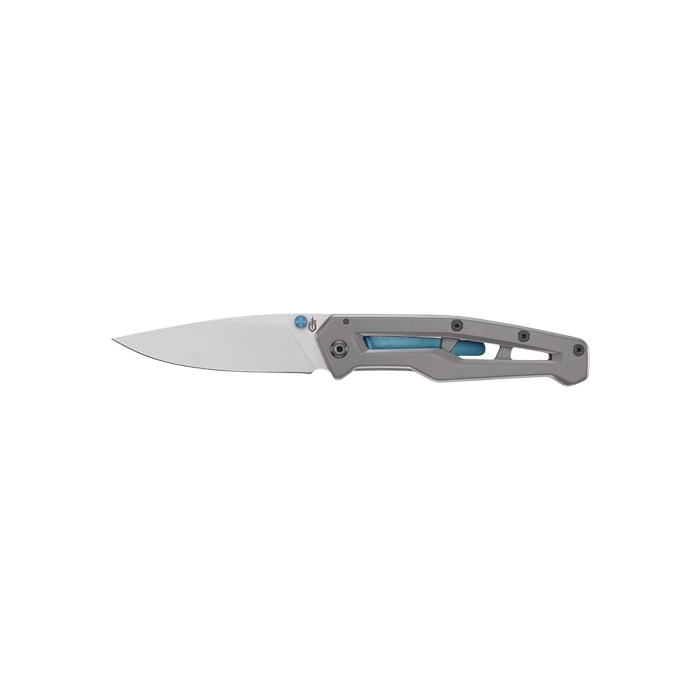
Gerber Paralite
Best Durable & Affordable Pocket Knife
CleverHiker Rating: 79.5
Price: $31
Measured Weight: 3.4 oz.
Blade Length: 3.1 in.
Overall Length: 7.3 in.
Blade Material: 5Cr13 Stainless Steel
Pros
- Affordable price
- Long blade
- Ergonomic handle design
- Easy to sharpen & maintain
- Very secure pocket clip
- Comfortable to carry in pocket
- Ambidextrous opening
Cons
- Can be difficult to close
- Not the most lightweight
- Clip can be hard to slide into pocket
The Gerber Paralite is an affordable and durable pocket knife that excels in portability. Its lightweight, skeletal frame and sturdy construction can handle daily tasks while remaining easy to carry in your pocket. The stainless steel blade is sharp and straightforward to maintain, offering dependable performance.
Dual thumb studs allow for ambidextrous opening, and the frame lock facilitates secure, one-handed closure. These features make it practical for quick access and safe handling, whether around a campfire or at a workbench. Additionally, the knife’s slim design doesn’t take up much space, making it an excellent choice for those who prefer a more compact tool.
However, the Gerber Paralite does have a few drawbacks. It lacks a spring-assisted opening mechanism, which could be a minor inconvenience for users who prefer quicker deployment or have limited dexterity. The clip design poses a challenge with some pocket materials, as it may need adjustment to fit securely onto thicker fabrics like jeans.
Overall, the Gerber Paralite is a solid choice for anyone who wants an affordable, durable, easy-to-carry knife. Its strengths in portability and construction outweigh the minor inconveniences, making it a valuable tool for everyday use.

Kershaw Blur
Workhorse Pocket Knife with an Ergonomic Handle
CleverHiker Rating: 84
Price: $115
Measured Weight: 3.9 oz.
Blade Length: 3.4 in
Overall Length: 7.9 in.
Blade Material: 14C28N Stainless
Pros
- Large blade
- Very sharp
- Assisted one-hand open
- Excellent grip
- Ergonomic thumb studs
- Reversible pocket clip
Cons
- Expensive
- Havier and bulkier than some
The Kershaw Blur is a big, sturdy pocket knife with a wide blade that’s excellent for carving and cutting with minimal effort. The handle is comfortable and has unique rubberized inserts for outstanding grip. We love the smooth action on the Blur too. It’s easy to operate with a single hand and quick to put away when you’re done. Because it’s so strong and easy to handle, the Blur is a great choice for anyone who needs a large blade they can count on for years of daily use.

SOG Twitch II
Small & Quick-Opening Pocket Knife
CleverHiker Rating: 77
Price: $45
Measured Weight: 2.6 oz.
Blade Length: 2.65 in.
Overall Length: 6.2 in.
Blade Material: AUS-8 Stainless
Pros
- Very sharp
- Slim and compact
- Assisted one-hand open
- Safety lock
- Reversible pocket clip
- Inconspicuous
Cons
- Small
- Takes two hands to close
If you want an inconspicuous pocket knife that’s sharp, fast to deploy, and comfortable to carry, the SOG Twitch II might be your jam. It’s very small and compact, so you can barely feel it in your pocket. The Twitch has assisted open, so it’s fun to unfold, and it works well when you need to use your blade frequently. Our one gripe is that the lockback locking mechanism takes two hands and requires a change of grip. That said, the Twitch is a high-quality knife for the price and an excellent choice for anyone who needs a small knife for everyday carry.
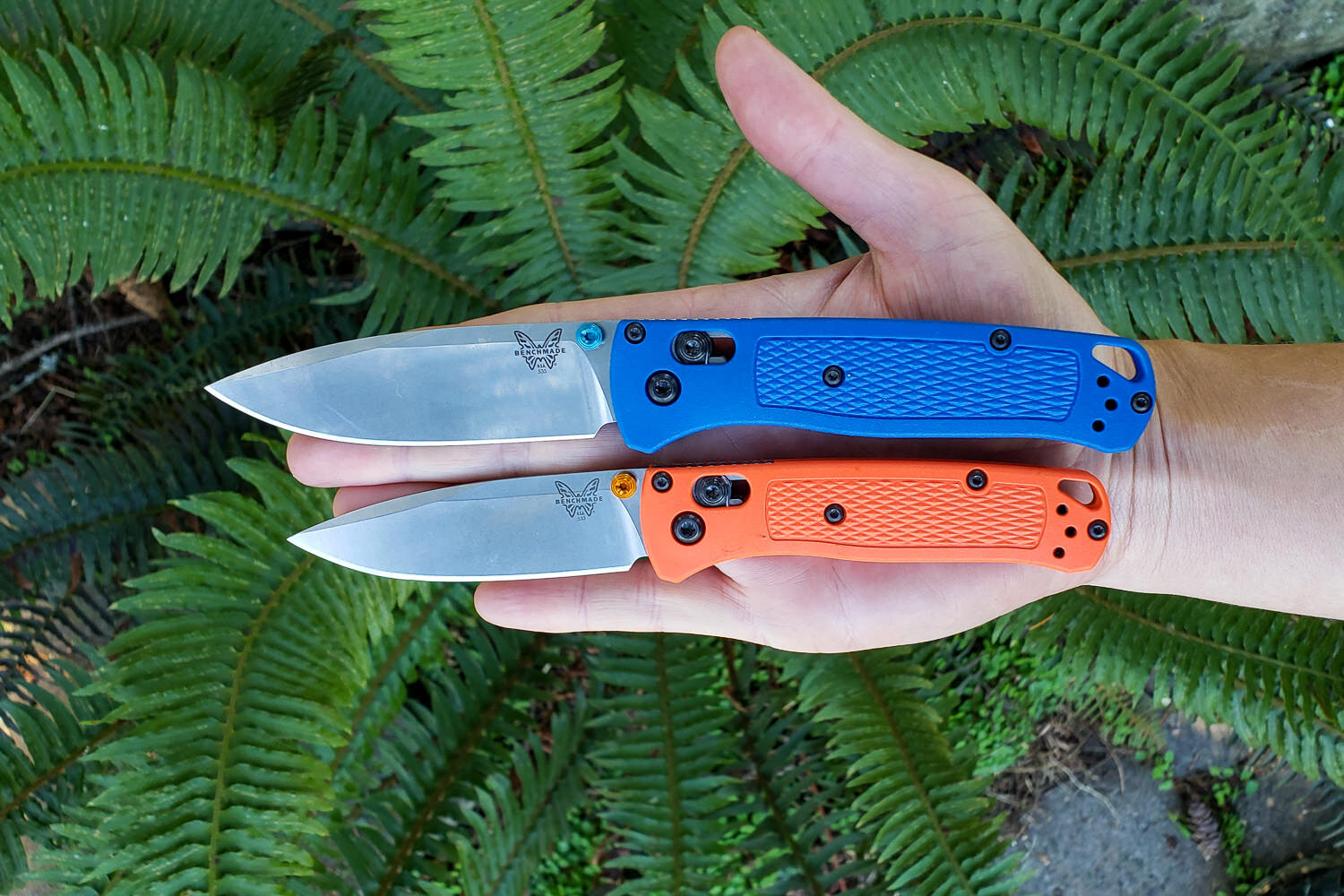
Product Comparison Table
| oSort | Product | Price | Measured Weight | Blade Length | Overall Length | Blade Material | Build Quality | Blade Retention | Ergonomics | Locking Mechanism | Corrosion Resistance | Weight Score | 0 |
Kershaw Leek View at Amazon |
$61 | 3 oz. | 3 in. | 7 in. | 14C28N stainless steel | 9 | 9 | 8 | 9 | 8 | 8 | 1 |
Benchmade Bugout 535 View at REI View at Amazon |
$180 | 1.9 oz. | 3.24 in. | 7.46 in. | CPM-S30V stainless steel | 8 | 8 | 8 | 9 | 8 | 9 | 2 |
Opinel No. 8 View at REI View at Amazon |
$19 | 1.5 oz. | 3.25 in. | 7.59 in. | 12C27 Sandvik stainless steel | 6 | 7 | 7 | 6 | 7 | 9 | 3 |
Spyderco Para Military 2 View at Amazon View at Cabela's |
$288 | 3.9 oz. | 3.42 in. | 8.24 in. | CPM S45VN steel | 9 | 9 | 8 | 9 | 8 | 7 | 4 |
CRKT Squid View at Amazon |
$40 | 3.5 oz. | 2.16 in. | 5.7 in. | 8Cr14MoV Steel | 8 | 8 | 7 | 7 | 8 | 9 | 5 |
Gerber Paralite View at Amazon |
$31 | 3.4 oz. | 3.1 in. | 7.3 in. | 5Cr13 Stainless Steel | 8 | 8 | 8 | 8 | 8 | 7 | 6 |
Kershaw Blur View at Amazon |
$115 | 3.9 oz. | 3.4 in | 7.9 in. | 14C28N Stainless | 9 | 8 | 9 | 8 | 7 | 8 | 7 |
SOG Twitch II View at Amazon View at Cabela's |
$45 | 2.6 oz. | 2.65 in. | 6.2 in. | AUS-8 Stainless | 8 | 7 | 8 | 8 | 7 | 9 |
|---|
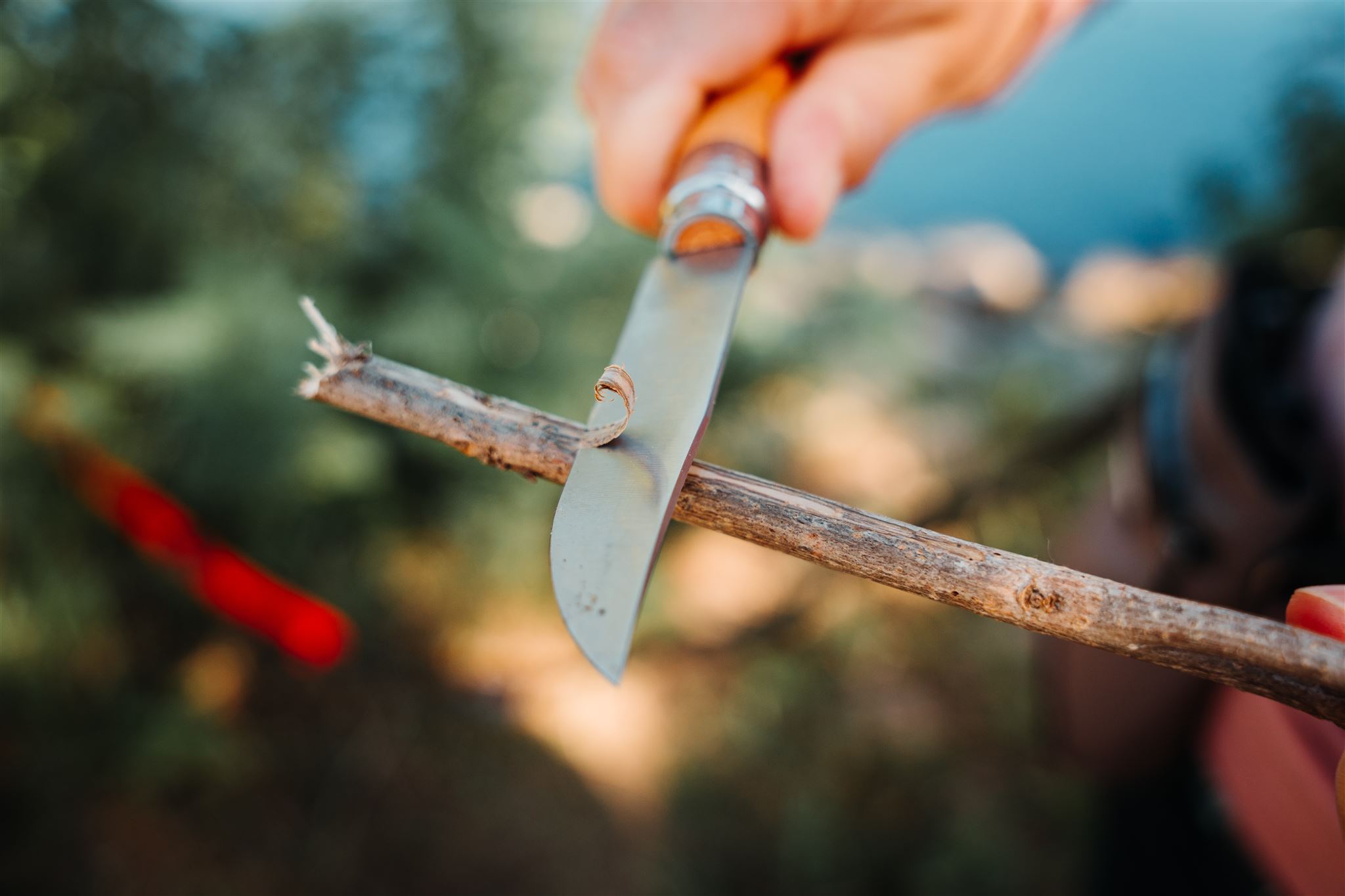
How We Test & Methodology
Our testing process involved evaluating each knife in real-world conditions over several weeks of use. Testing was completed in tester’s backyards and garages, on the trail, while camping, and during lake days. We subjected the knives to assessments in diverse environments, including exposure to outdoor elements and extended cutting tasks.
BUILD QUALITY
We evaluated build quality by closely inspecting the knife’s craftsmanship, including the materials used and overall construction when new and also after extended use. We checked for attention to detail in the fit and finish of the knife, looking for any imperfections or signs of poor workmanship. This involved assessing the durability of materials, the alignment of components, and the overall robustness of the knife to ensure it met high standards of durability and quality.
BLADE RETENTION & STABILITY
We tested how well each knife maintained its sharpness after repeated use to evaluate blade retention and stability. We cut through various materials such as cardboard, rope, paper, and foods (mainly produce) to simulate everyday tasks and assessed how the blade’s edge held up under stress. We also tested the blade’s stability by applying pressure and observing if there was any noticeable wobbling or movement.
CORROSION RESISTANCE
We assessed corrosion resistance by exposing each knife to environments that simulate real-world conditions. Each knife was subjected to a saltwater solution to test its resistance to rust and corrosion. After exposure, we inspected the blades and handles for any signs of deterioration, such as rust spots or pitting, to determine how well the knife could withstand moisture and other corrosive elements over time.
ERGONOMICS & GRIP
We tested ergonomics and grip by handling the knife in various ways, including regular, reverse, and pinch grips. We performed cutting tasks and evaluated the knife’s comfort, balance, and control. This involved using the knife for extended periods to simulate real-world use and assessing how well the handle design supported different grips and prevented slipping. We aimed to see if the knife felt comfortable and secure for various hand sizes and handling conditions.
LOCKING MECHANISM
The locking mechanism was tested for reliability and strength by repeatedly opening and closing the knife under different stress levels. We applied varying amounts of force to assess how well the lock held the blade in place. Additionally, we tested the mechanism’s performance in challenging conditions, such as when the knife was dirty or wet, to ensure consistent and safe operation throughout various scenarios.
WEIGHT
Weight was measured using a digital kitchen scale and compared to the manufacturer’s product specs for accuracy. A knife’s weight can determine its balance and portability. We also evaluated how the knife felt during use. This testing helped us find a balance between the knife’s weight and its functionality.
Why Trust CleverHiker
At CleverHiker, we pride ourselves on delivering expert, trustworthy reviews to help you make informed decisions. Gear Analyst, Meg Carney, brings a wealth of experience to our pocket knife assessments. With over seven years as a freelance writer specializing in outdoor and environmental topics, Meg has honed her expertise through extensive product journalism for respected industry publications.
Meg’s hands-on experience evaluating several of the over 30 pocket knives tested by the CleverHiker team backs her credibility. Our testing covered a broad range of real-world conditions, from backyard tasks to hikes in Washington and lakeshore environments in Minnesota. This testing ensures that our recommendations are based on comprehensive, practical insights, reflecting our expertise and quality commitment.
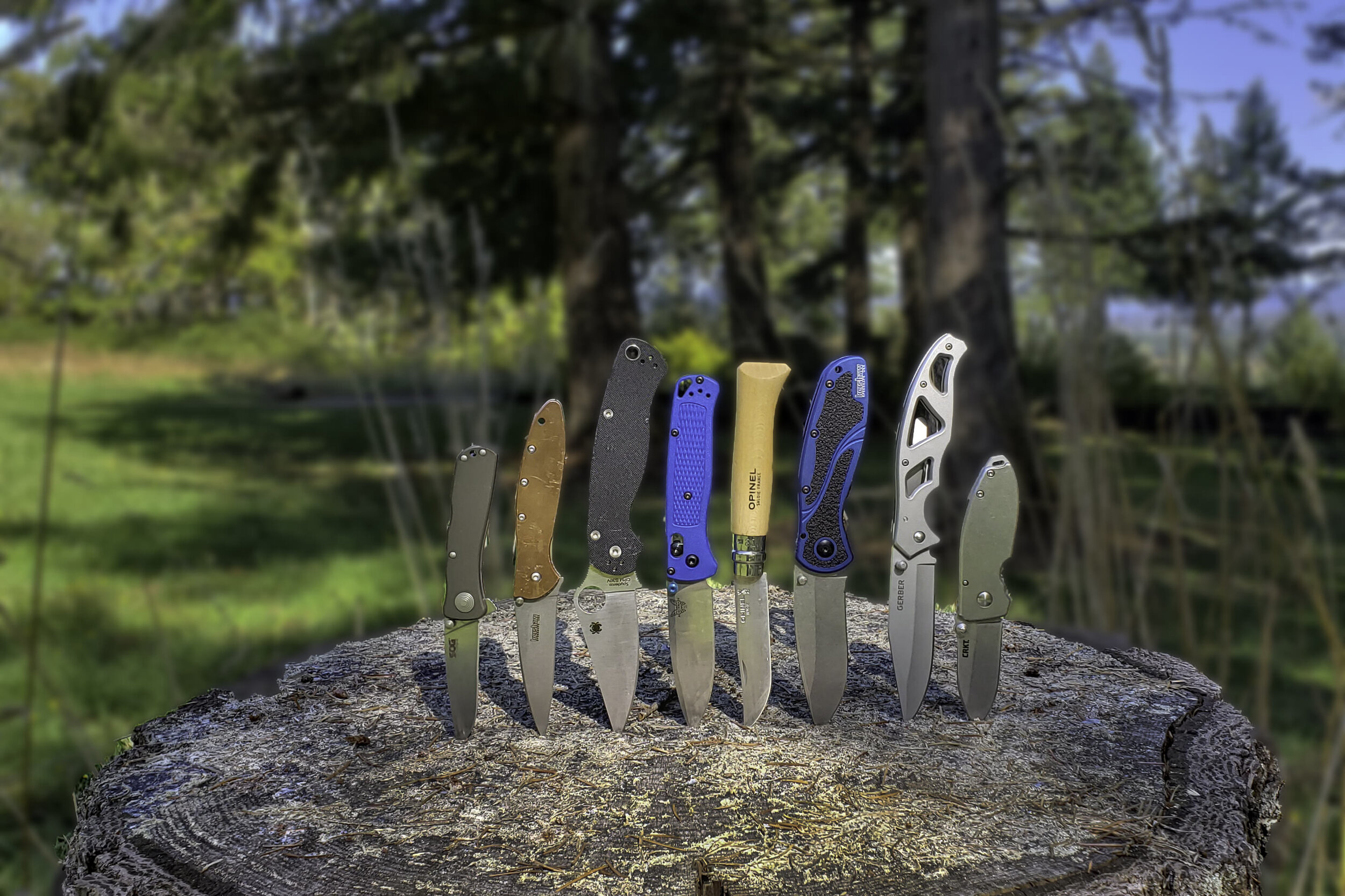
Analysis & Results
We rate our pocket knives based on specific metrics– blade quality, blade retention/stability, ergonomics and grip, locking mechanism, corrosion resistance, and weight. See how they performed in our real-world testing below.
VALUE
Balancing cost with performance helps us find the best value when selecting a pocket knife. The Opinel No. 8 is our top budget pick, offering impressive functionality at a low price. Its simple yet effective design delivers reliable cutting power and ease of use. For those willing to invest a bit more, the CRKT Squid provides an excellent balance of quality and affordability. Its compact size and solid construction make it ideal for everyday carry, delivering durability and practicality without a hefty price tag. On the higher end, the Spyderco Para Military 2, priced at a premium, offers top-tier performance with advanced features and top-of-the-line materials. This knife is for enthusiasts who prioritize superior craftsmanship, precision, and durability.
BUILD QUALITY
Assessing build quality can help you determine a pocket knife’s overall durability and performance. We prioritize knives that showcase durable, long-lasting materials. The Spyderco Para Military 2 is our premium knife option and has among the best build quality, featuring high-grade materials like a high-carbon stainless steel blade. The Kershaw Leek offers a sleek design and sturdy materials for those seeking a reliable and well-constructed knife at a lower price. On a more budget-friendly note, the Opinel No. 8 provides solid performance and functional design, reflecting a simpler build with more noticeable imperfections. Each knife demonstrates different levels of build quality, catering to various needs and price ranges.
BLADE RETENTION & STABILITY
We focus on how well a knife maintains its sharpness and stability under real-world conditions to assess blade retention and stability. The Benchmade Bugout 535 shines in this metric with exceptional blade retention, keeping a sharp edge even after extensive use. The Kershaw Leek also performs admirably, with its blade retaining sharpness well and showing stability during use, whether chopping produce or whittling down a stick. It handles continuous cutting tasks without significantly dulling, requiring less frequent maintenance. The Opinel No. 8 demonstrates decent blade retention for its price point but requires more frequent sharpening compared to higher-end models.
ERGONOMICS & GRIP
Evaluating ergonomics and grip involves assessing how comfortable and secure a knife feels during use, considering various hand sizes and handling conditions. The Spyderco Para Military 2 excels in ergonomics. Its G-10 textured handle provides an excellent grip, and its design comfortably supports various hand sizes. It is one of the largest knives on the list, so users with bigger hands may find it easier to balance and control.
Similarly, the Kershaw Leek also scored well for ergonomics and grip performance. Its sleek design and contoured handle offer a comfortable grip and prevent slipping. The CRKT Squid provides solid performance for its price but is quite small. Its compact size and handle design offer a secure grip, though due to its small size, it may not be as comfortable for extended or for users with larger hands.
LOCKING MECHANISM
A knife’s locking mechanism influences its reliability and strength through repeated opening and closing. The Benchmade Bugout 535 has an Axis Lock system that uses a small, hardened spring-loaded bar you can move back and forth to unlock the knife. The lock is dependable, but it can be tricky to close it at first. The Spyderco Para Military 2 also has a strong, reliable locking mechanism. Its compression lock is on the back of the handle and uses a rocker arm that pivots at the center. The blade’s tang is engaged with the lug on one end of the arm to lock the blade open.
CORROSION RESISTANCE
The Benchmade Bugout 535 has a stainless steel blade and performs well under saltwater exposure, showing minimal signs of rust or pitting. The knife’s materials and construction effectively resist corrosion, making it a durable choice for various environments, especially outdoors. The Spyderco Para Military 2 also demonstrates strong resistance to rust and corrosion. The robust construction and protective coating helps maintain the knife’s performance and appearance even in challenging conditions.
In contrast, Opinel No. 8 shows some vulnerability to corrosion. Despite its affordable price, the carbon steel blade is more prone to rust and requires frequent maintenance to prevent deterioration. While it offers good value, its corrosion resistance is less impressive.
WEIGHT
We considered how the weight felt during use to find an optimal balance between ease of carry and functionality. The Benchmade Bugout 535 is only 1.9 oz, making it one of the lightest options on our list. This ultralight design enhances its portability, making it ideal for those who prioritize cutting down ounces on the trail. The Kershaw Leek, weighing in at 3 oz, offers a balanced combination of lightness and durability. It provides a comfortable carry experience without feeling overly heavy, making it a versatile choice for everyday use. The heaviest knife featured is the Spyderco Para Military 2, which weighs 3.9 oz. While it is heavier, we feel the weight is justified with premium construction and advanced features.
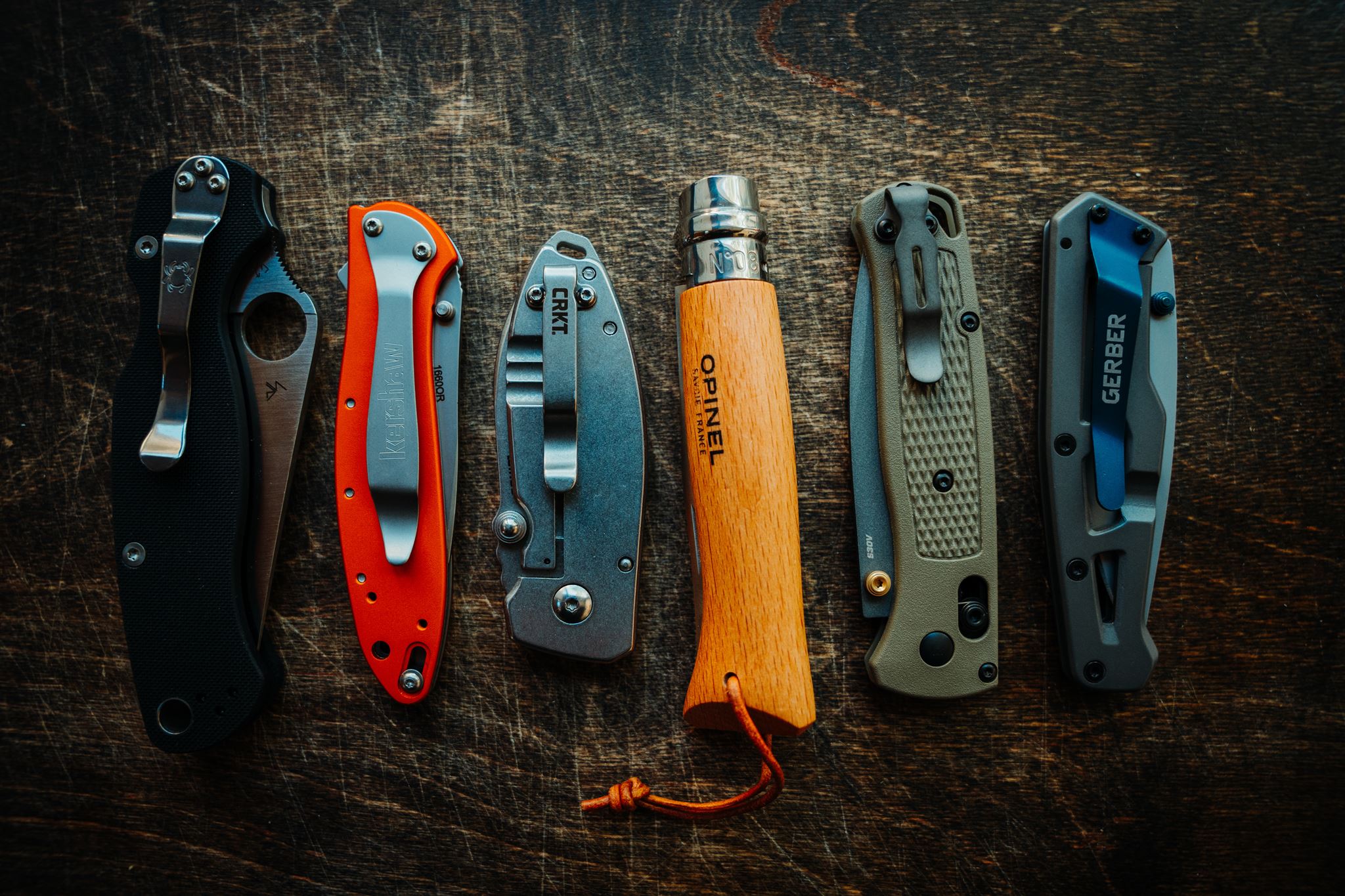
How to Choose a Pocket Knife
USE
A good pocket knife comes in handy in all kinds of unexpected situations, but consider what you intend to use your knife for most often. If you see yourself sawing through rope or skinning rabbits, you may want to consider a more specialized blade made for climbing or bushcraft. On this list, we focus mostly on well-rounded pocket knives for everyday carry, whether you’re pulling weeds in the garden, repairing gear before a day hike, or starting a fire in the backcountry.
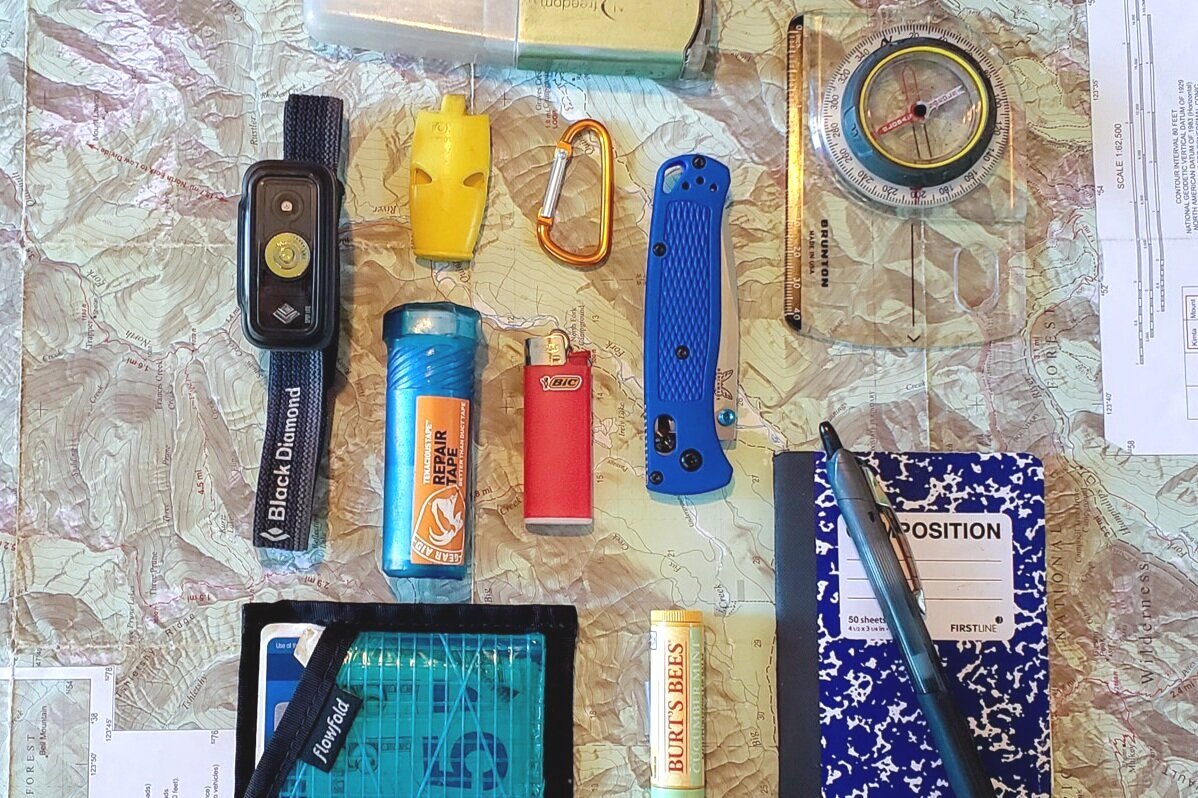
SERRATED VS. PLAIN EDGE
Serrated edges have a series of small, tooth-like ridges that can be particularly useful for tasks involving tougher materials. The design of a serrated blade allows it to cut through fibrous materials such as rope, branches, or even meat more effectively than a plain edge.
However, serrated edges are more challenging to sharpen at home than plain edges. Because the teeth are small and irregular, they require specialized sharpening tools or professional services to maintain their sharpness. Additionally, serrated edges can consume more blade real estate, reducing the length of the plain edge available for slicing tasks. This can make the knife less versatile.
That’s why we prefer a simple, plain edge. If you keep it sharp, it will almost always perform better and be more versatile than a serrated one. A well-maintained plain edge can handle a wide range of cutting tasks, from slicing vegetables to cutting paper, and is typically easier to sharpen using household tools or sharpening stones. The uninterrupted cutting surface allows for clean, precise cuts, making it a preferred choice for everyday tasks where versatility and ease of maintenance are essential.
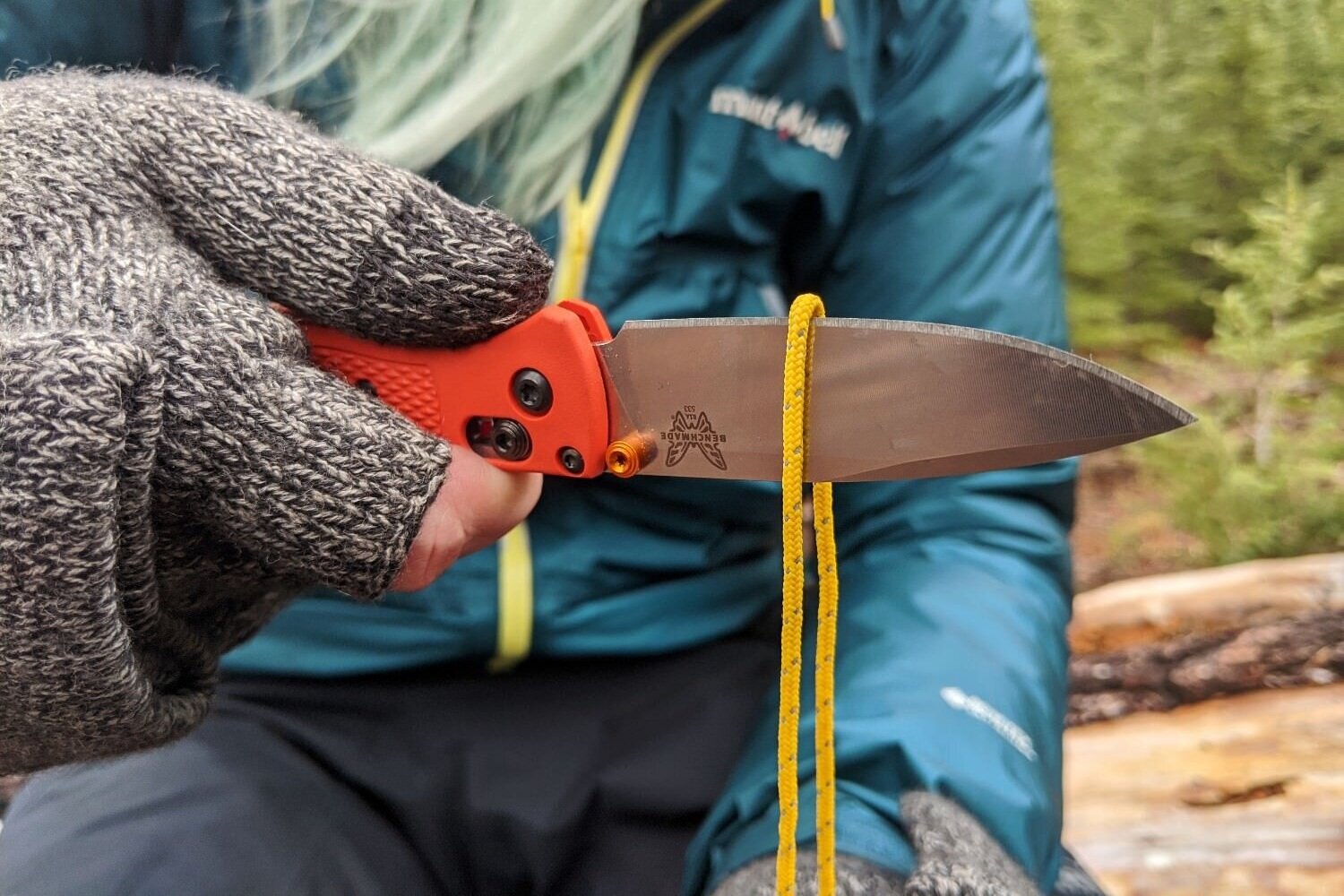
LOCK TYPE
A sturdy lock mechanism makes your knife safer to use during cutting tasks. Each lock type has advantages and considerations that influence the knife’s performance.
The frame lock is a popular choice in high-quality knives. It utilizes a steel lock bar integrated into the handle’s frame. As the blade opens, the lock bar shifts into position, securely locking the blade against the handle. This mechanism is strong and simple, but frame locks tend to wear over time, particularly with heavy use.
In contrast, the liner lock is built into the knife’s liner. When the blade is opened, a portion of the liner slides into a notch on the blade, securing it in place. Liner locks are known for their ease of use and reliability, allowing for smooth, one-handed operation. Despite their advantages, they too can experience wear and may be affected by dirt or debris.
The compression lock, favored by brands like Spyderco, operates by compressing a stop pin against the blade tang. This lock offers better security and smoother operation, ensuring the blade remains firmly in place even with heavy use.
Another option is the detent lock, which employs a spring-loaded ball bearing that locks into a detent in the blade. This provides a simple, effective lock with secure blade engagement and a lightweight design. However, it might not hold as well or be as strong as other lock types.
The collar lock, or ring lock, features a rotating collar that encircles the blade’s base when the knife is open, as seen on the Opinel No. 8. This design provides a secure lockup, making it highly reliable for preventing accidental blade closure. It requires more effort than simpler mechanisms but still gives you a secure blade hold.
Lastly, the back lock is found in many traditional pocket knives and features a spring-loaded lock at the back of the handle. This lock engages a notch in the blade, holding it securely open. While durable and reliable, back locks typically require two hands for operation—one to hold the handle and the other to release the lock.
All the knives on our list are equipped with strong frame, liner, compression, or collar locks to keep the blade safe and securely fixed in position when open.
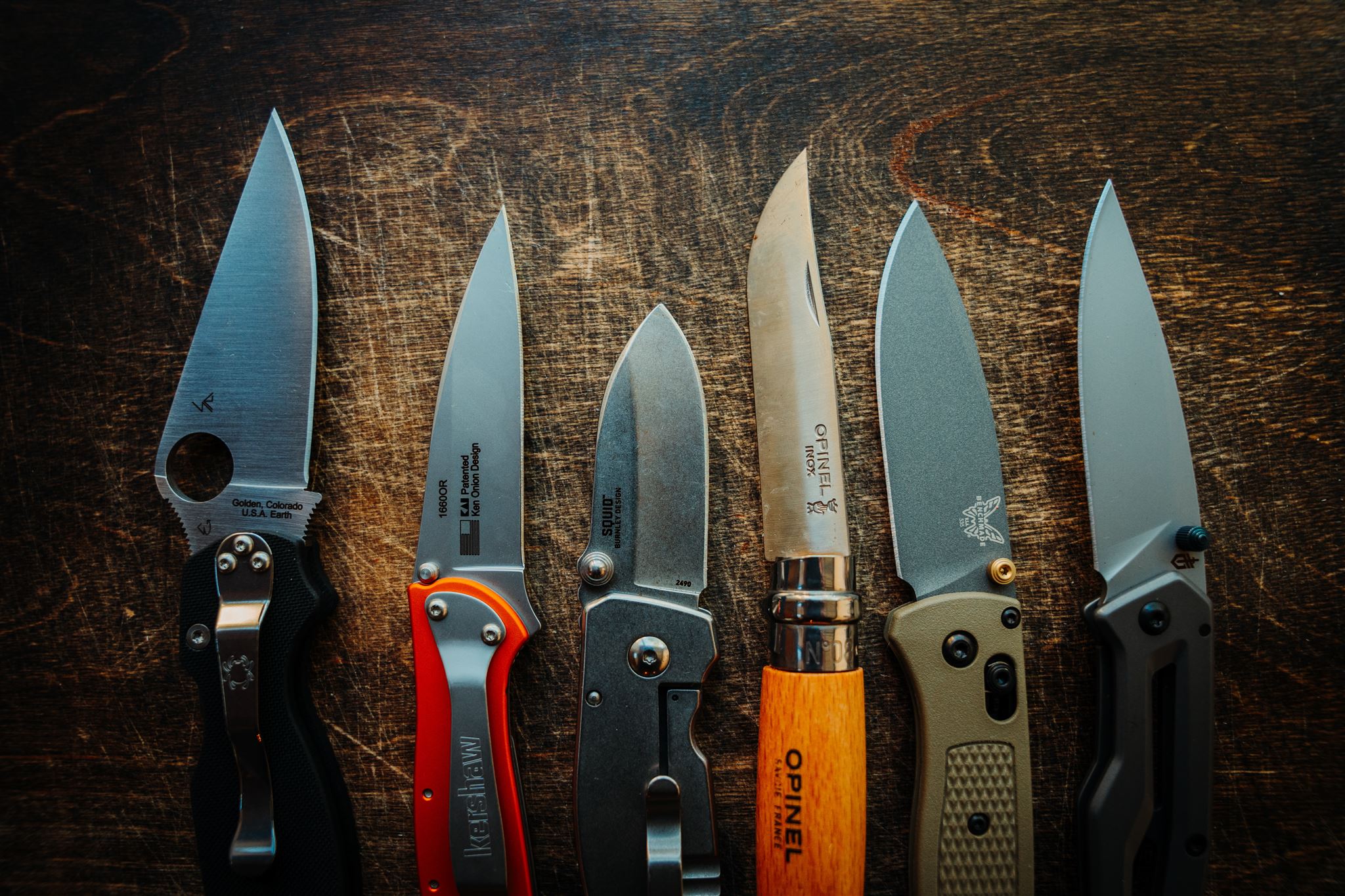
SIZE & WEIGHT
A pocket knife should be compact and light enough that it won’t bother you to carry it in your pocket, but large enough to fit comfortably in your palm and be adequate for the task at hand.
A good guideline for everyday carry (EDC) is that the knife should be around 4 inches long when closed. This size balances portability and usability, making it easy to carry without being overly intrusive. When open, the blade length typically ranges from 2.5 to 3.5 inches, providing enough cutting surface for most daily tasks while remaining manageable.
A desirable weight for EDC knives is about 4 ounces or less. Lighter knives, generally under 3 ounces, are easier to carry and less likely to cause discomfort when kept in your pocket throughout the day. They are ideal for those who value minimalism or ultralight setups. Heavier knives, while potentially offering more durability and a more substantial feel, can become cumbersome if carried for extended periods. They may be preferred for tasks requiring more cutting power or when used in scenarios where extra strength is beneficial.
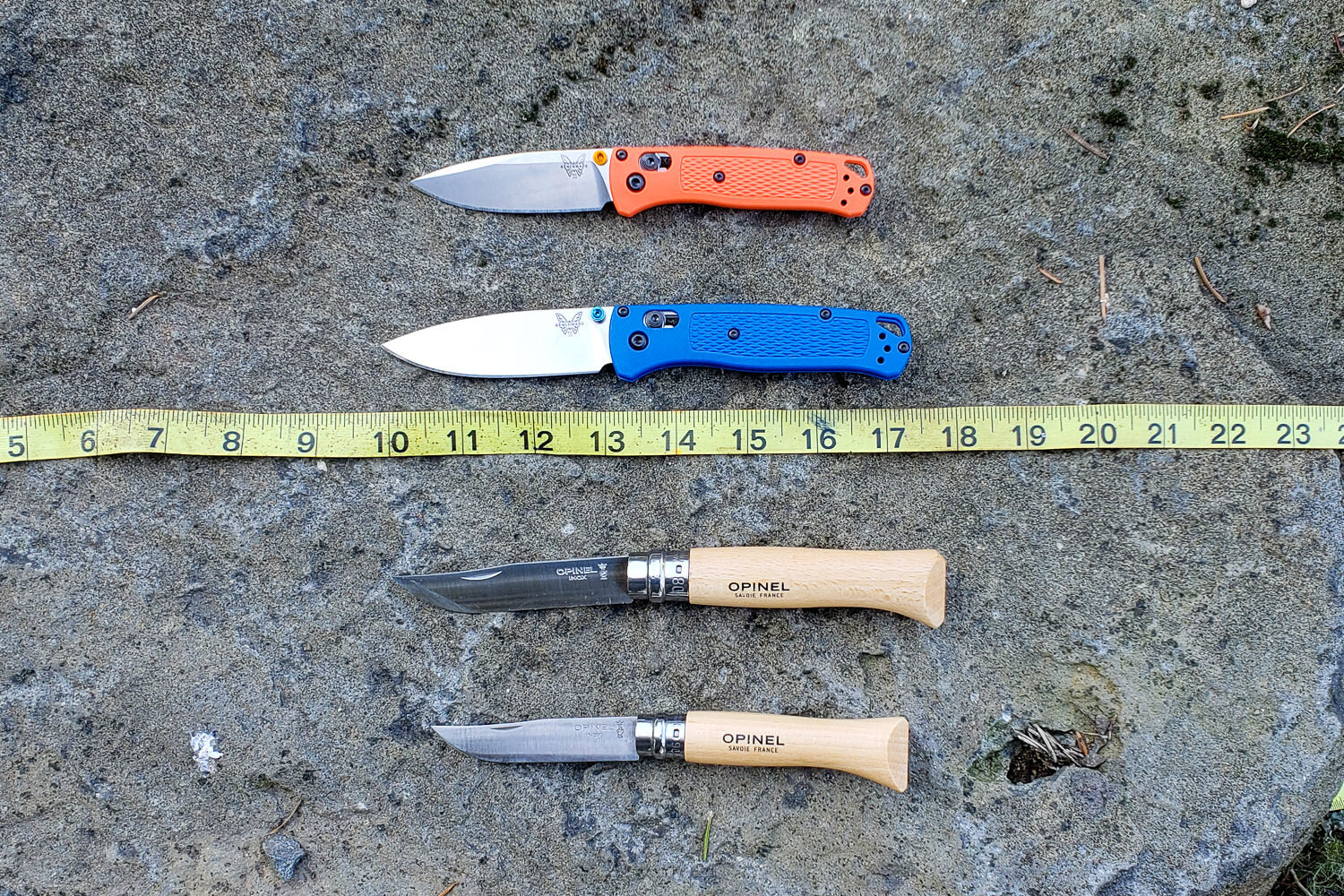
BLADE SHAPE
The knives on our list have a range of blade shapes, but most are some form of the classic drop-point, which offers excellent versatility for various cutting and slicing tasks. It features a curved, convex edge that drops towards the tip. The drop-point’s tip allows for controlled cutting and piercing, making it a reliable choice for everyday carry.
Another shape is the clip-point, which has a concave cut along the blade’s top, creating a sharp, pointed tip. The spear-point blade is symmetrical with a central point, making it effective for piercing and stabbing. It excels in tactical situations but is less versatile for slicing. The tanto blade features a strong, angular tip and flat cutting edge, offering excellent durability and impact resistance, but less suited for general slicing. Finally, the Wharncliffe blade has a straight edge with a sharp, curved point, which is perfect for precision cutting but less effective for heavy-duty use.
Each blade shape offers distinct advantages, catering to different needs and preferences. To learn more, check out this Knife Blade Shapes Guide.
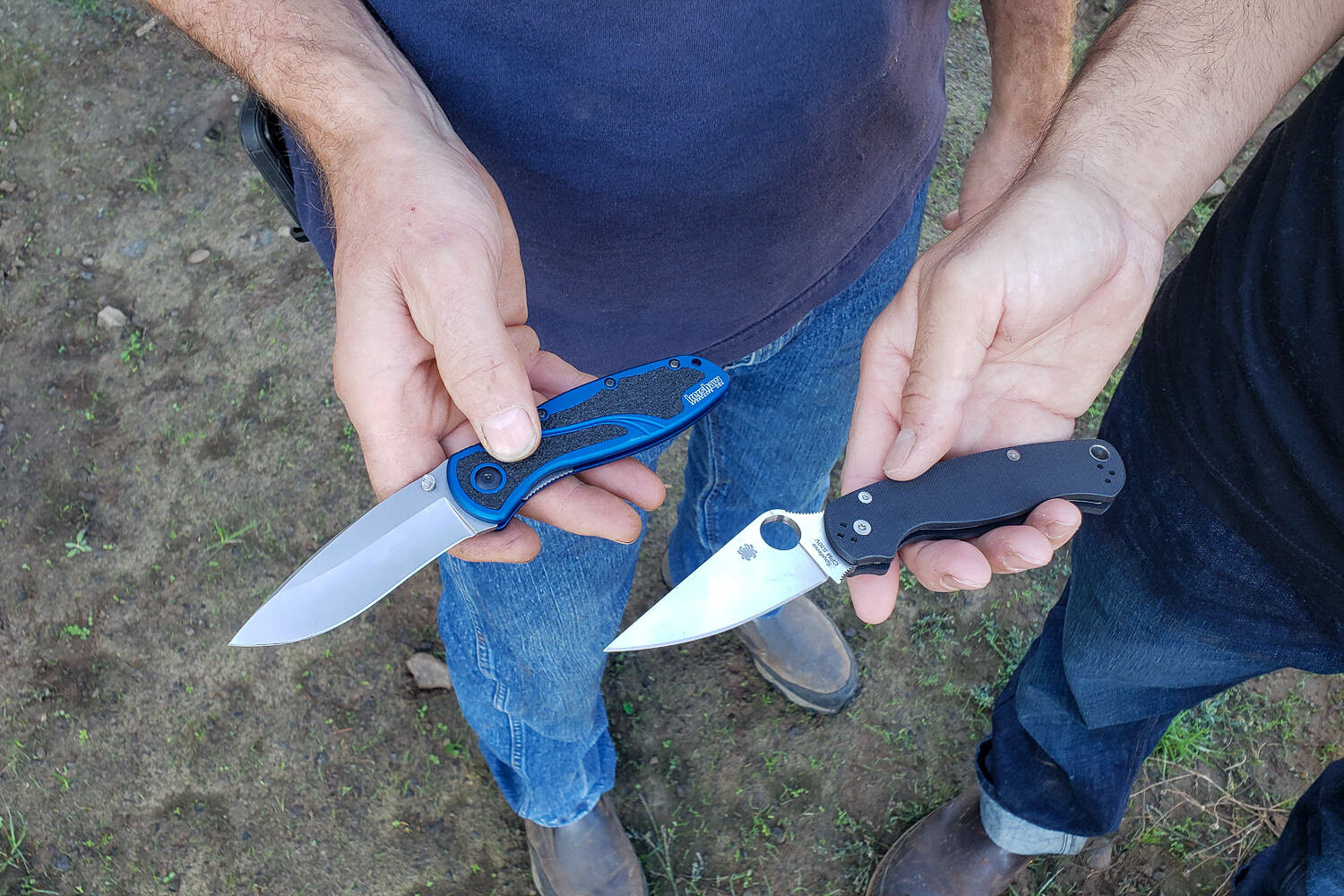
BLADE STEEL
Understanding knife blade steel involves grasping five key elements: hardness, toughness, wear resistance, corrosion resistance, and edge retention.
Hardness refers to the steel’s ability to maintain its edge, measured on the Rockwell scale; harder steels hold an edge longer but can be more brittle. Toughness indicates how well the steel can withstand impacts and resist chipping. Wear resistance is how well the blade retains sharpness over time, especially with frequent use. Corrosion resistance determines the steel’s ability to resist rust and staining, vital for knives exposed to moisture. Lastly, edge retention measures how long the blade stays sharp before needing to be honed. These factors influence the knife’s cutting performance, durability, and maintenance needs.
Check out the Essential Guide to Knife Steel if you want to know more about a specific blade.
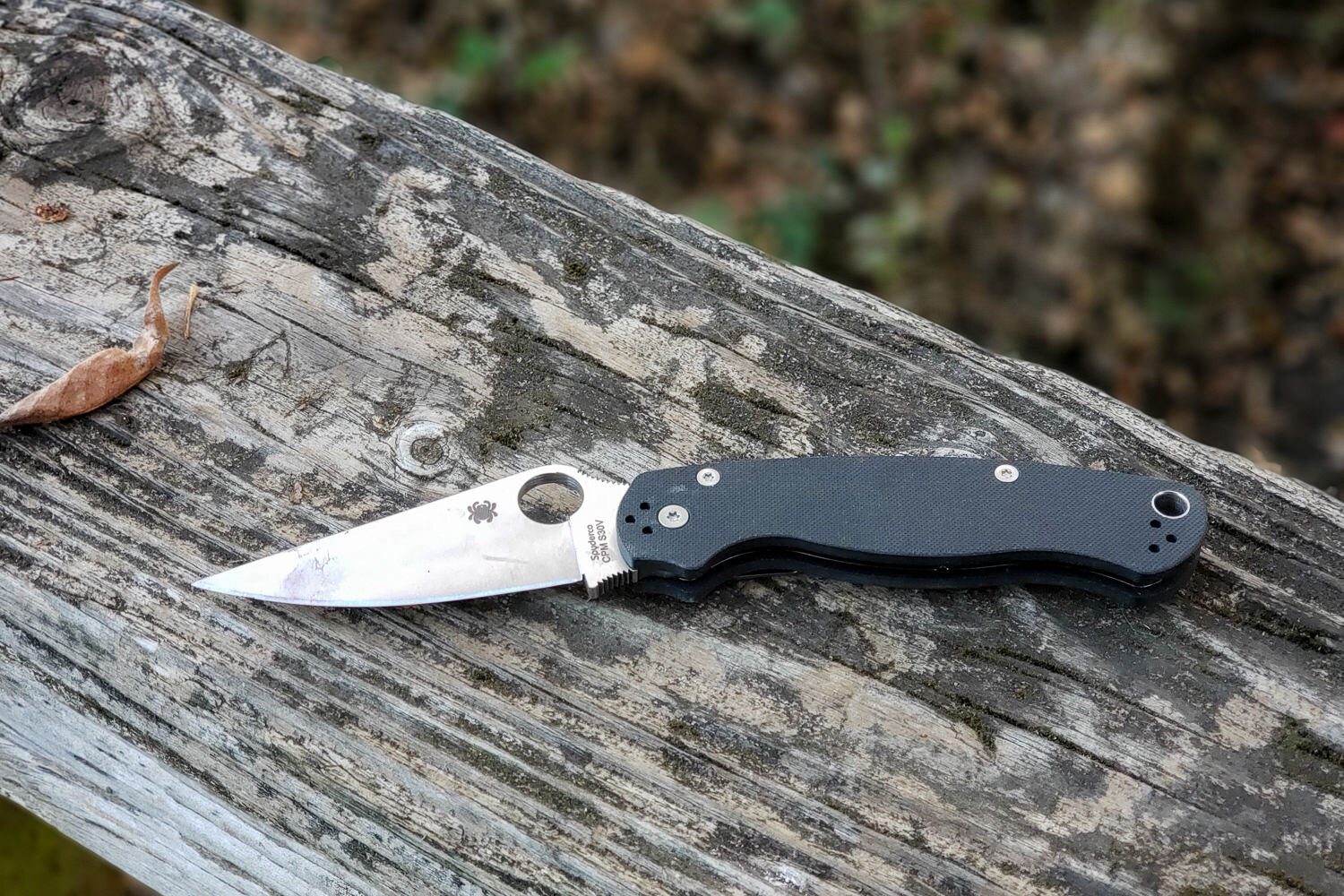
HANDLE MATERIALS
The handle is an integral part of the pocket knife equation: if it is too heavy and bulky, the knife is cumbersome, but if it is too light and flimsy, the knife will feel weak. The best knives have ergonomic, comfortable, grippy, and durable handles. G-10, a type of laminate commonly used in knife handles, is a good all-around material for its lightweight and texture, but you might prefer materials like anodized aluminum or wood.
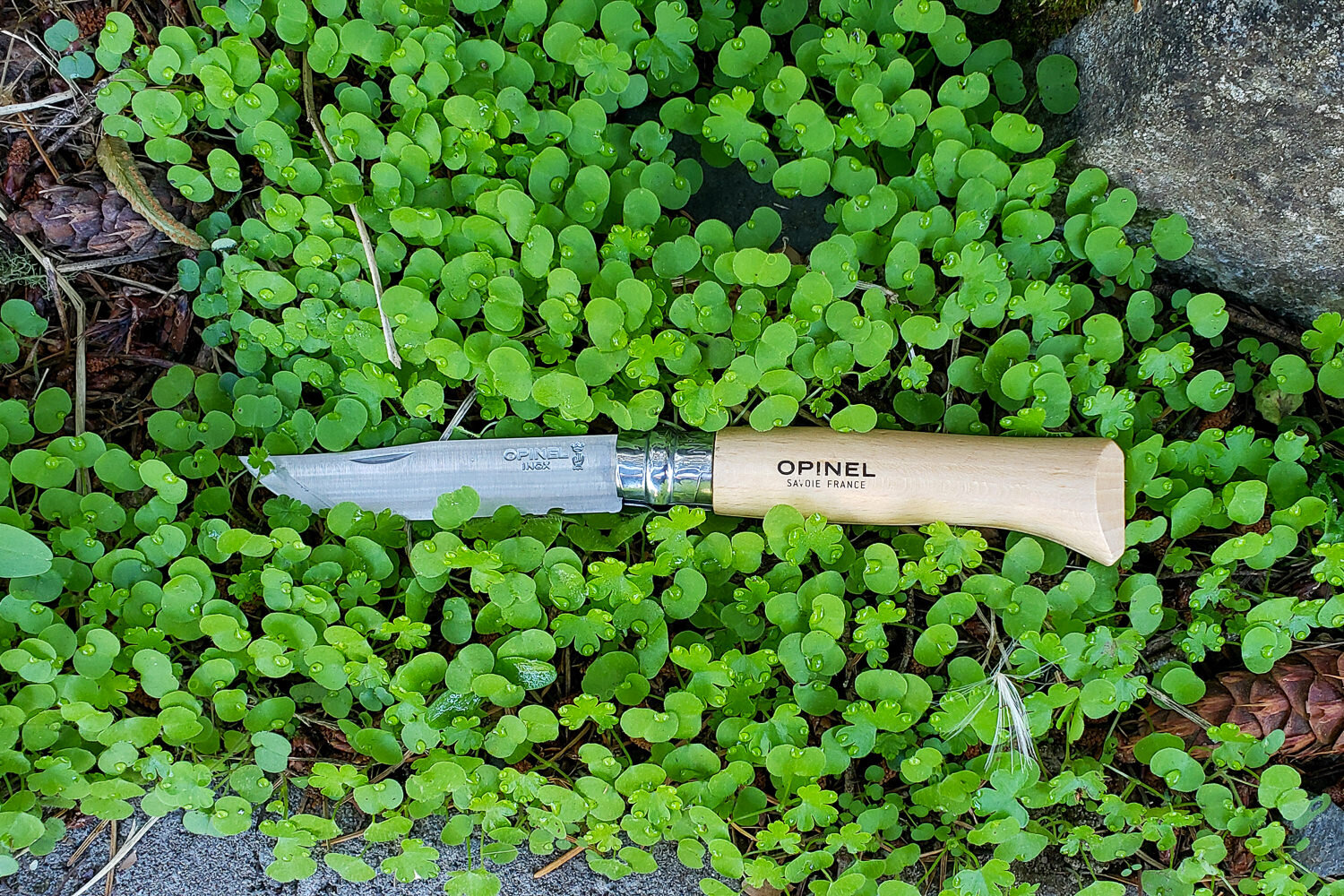
STYLING
Once you’ve gone over the considerations above, you can narrow your search to knives that appeal to you aesthetically and fit your style. You might want a tough-looking tactical blade, a sleek knife that won’t scare people at the office, or a traditional, old school design.
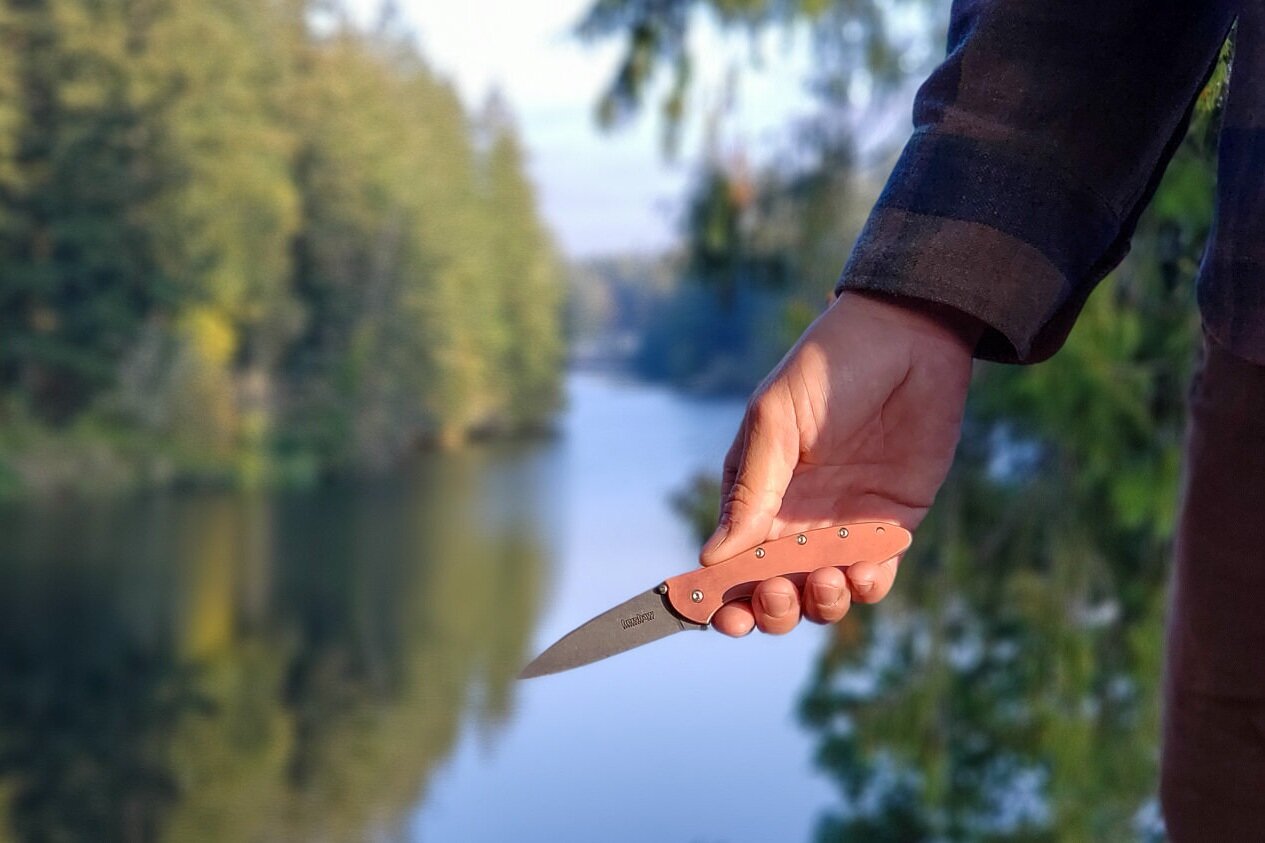
POCKET CLIP
Most people carry their knives in their pants pockets. The knife should rest inside the pocket with the closed blade flush with the front or back seam so you can grab the knife easily and prevent the blade from accidentally falling open. Some knives have pre-drilled holes so you can choose the position that suits you best. If you prefer to be inconspicuous and not draw attention to the fact that you’re carrying a knife, look for a deep carry pocket clip that keeps the blade hidden – some knives include this.
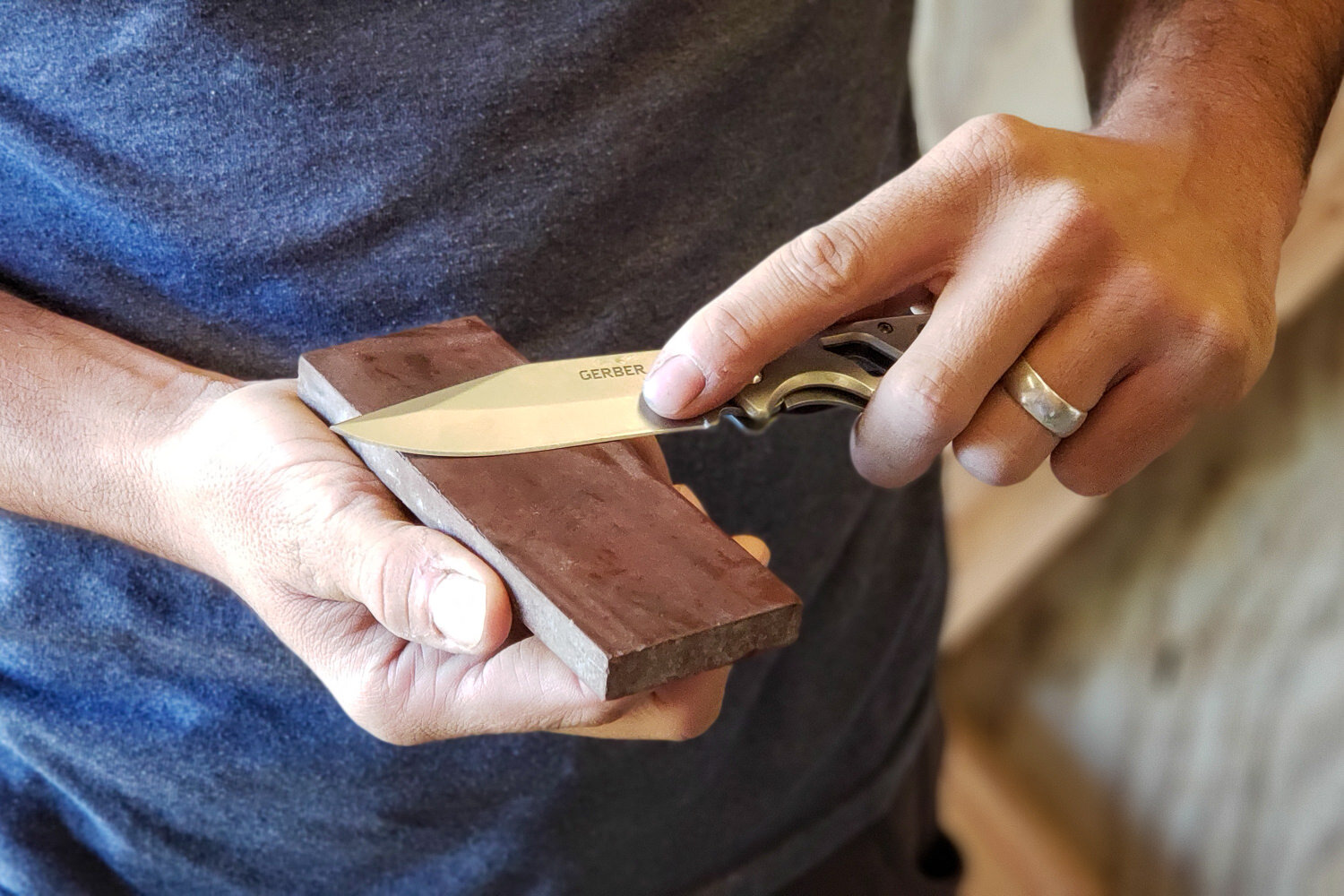
Conclusion
Choosing the right pocket knife is essential for ensuring you have a reliable tool for everyday tasks and emergencies. Whether you need a knife for intricate cutting, heavy-duty use, or everyday carry, factors like blade shape, steel quality, and locking mechanisms influence performance and safety. With a range of options available, we hope this guide helps you find the perfect pocket knife to complement your lifestyle and meet your cutting needs.



